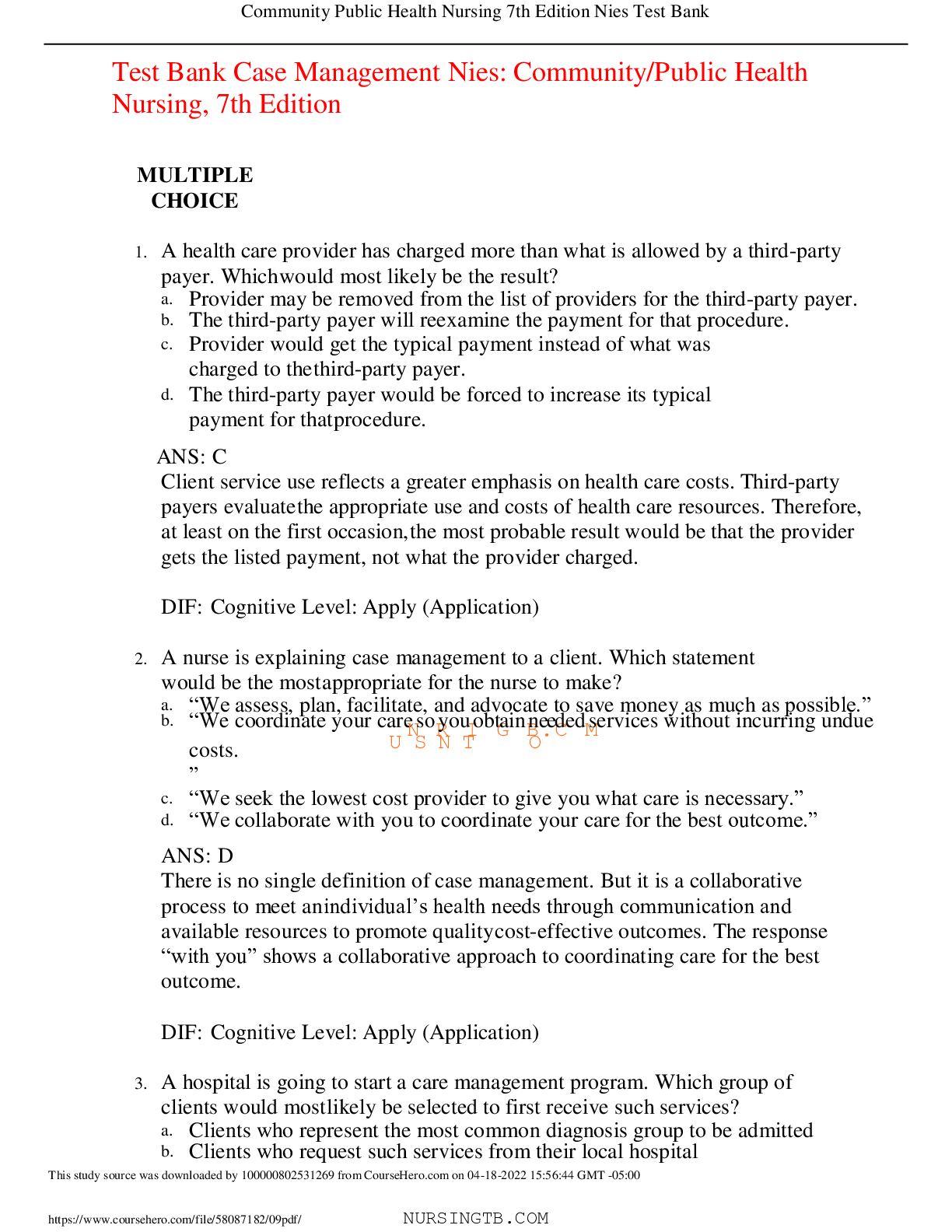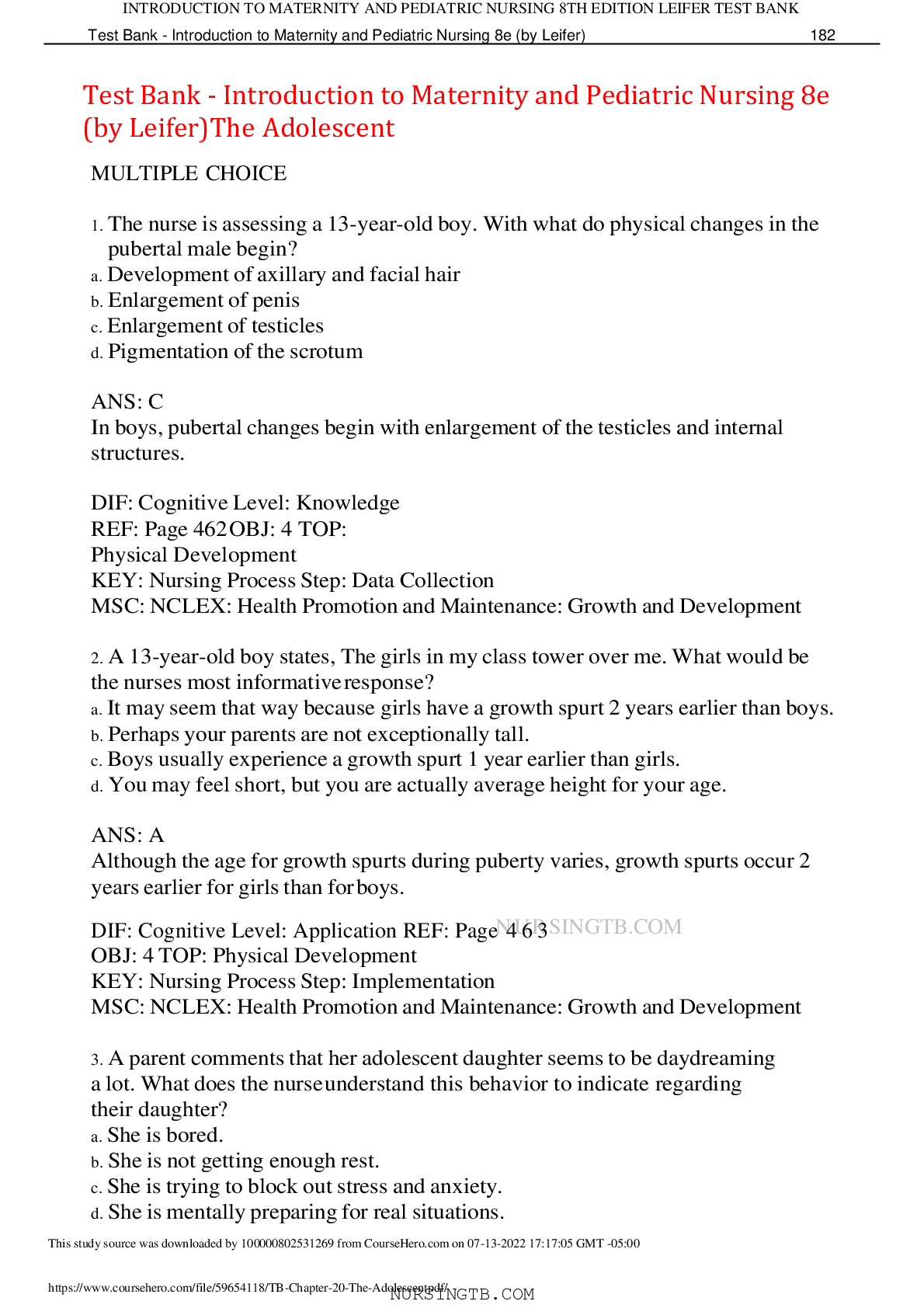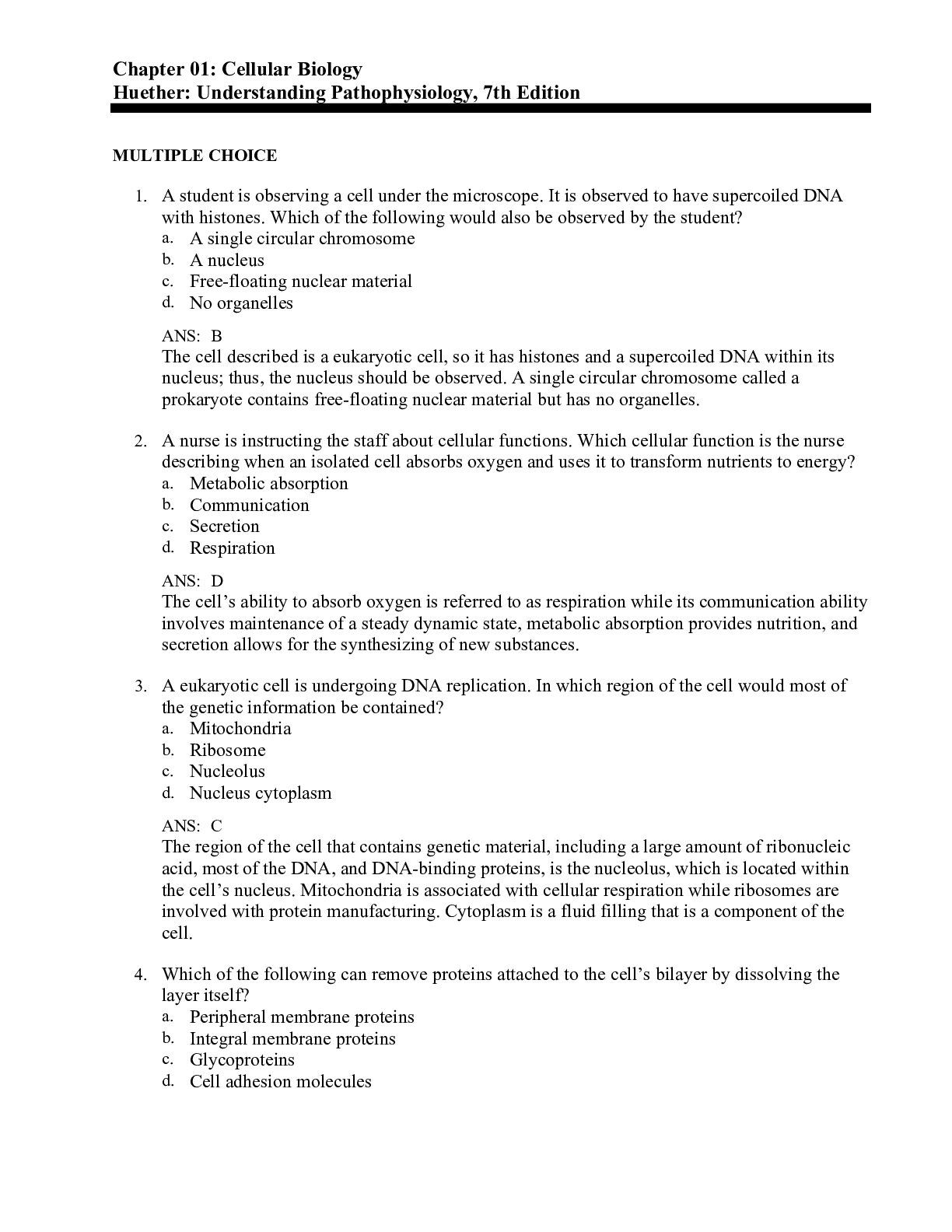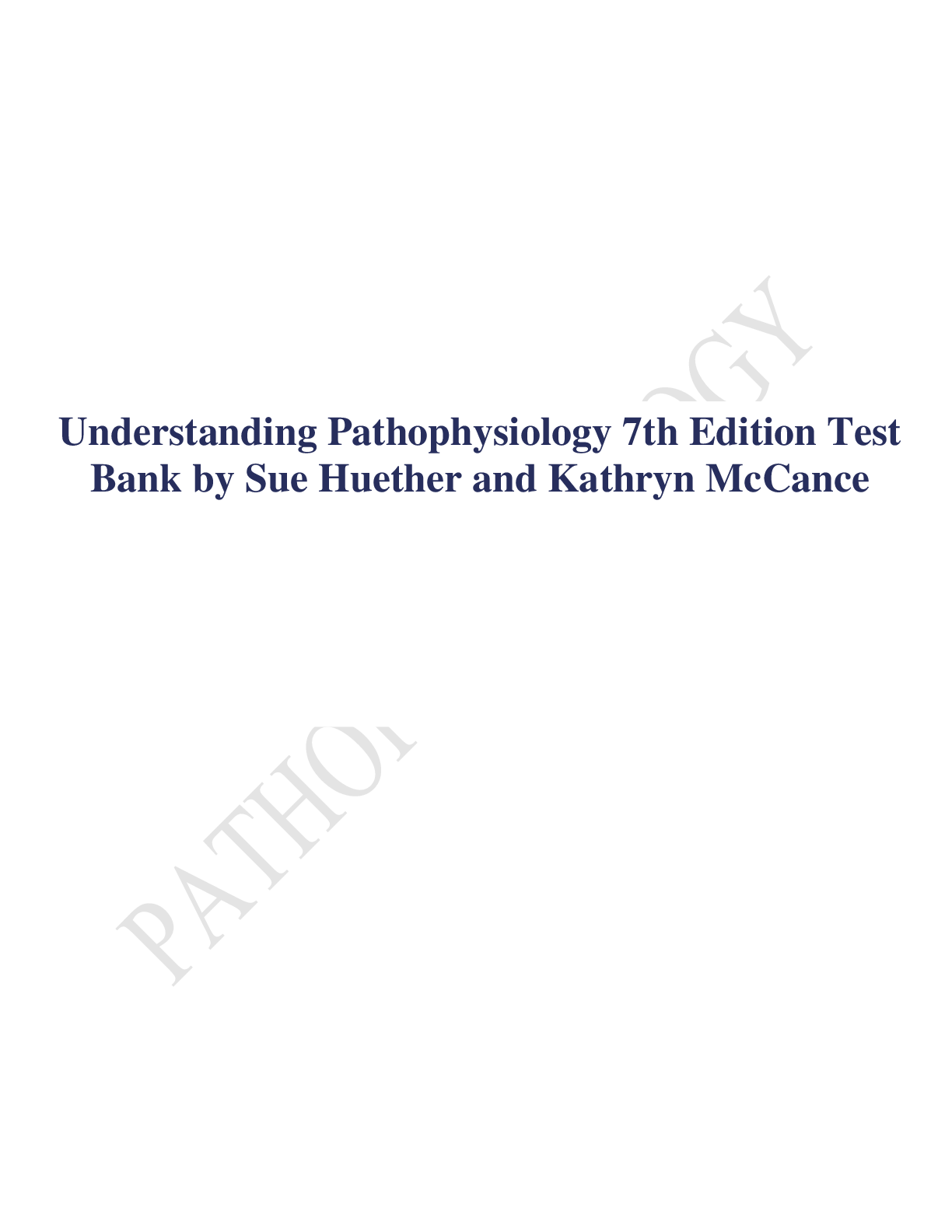*NURSING > TEST BANK > Test Bank: Cellular Biology Huether: Understanding Pathophysiology, 7th Edition,100% CORRECT (All)
Test Bank: Cellular Biology Huether: Understanding Pathophysiology, 7th Edition,100% CORRECT
Document Content and Description Below
Test Bank: Cellular Biology Huether: Understanding Pathophysiology, 7th Edition MULTIPLE CHOICE 1. A student is observing a cell under the microscope. It is observed to have supercoiled DNA wi... th histones. Which of the following would also be observed by the student? a. A single circular chromosome b. A nucleus c. Free-floating nuclear material d. No organelles ANS: B The cell described is a eukaryotic cell, so it has histones and a supercoiled DNA within its nucleus; thus, the nucleus should be observed. A single circular chromosome called a prokaryote contains free-floating nuclear material but has no organelles. 2. A nurse is instructing the staff about cellular functions. Which cellular function is the nurse describing when an isolated cell absorbs oxygen and uses it to transform nutrients to energy? a. Metabolic absorption b. Communication c. Secretion d. Respiration ANS: D The cell’s ability to absorb oxygen is referred to as respiration while its communication ability involves maintenance of a steNadUyRdSyInaNmGicKsItaNteG,.mCeOtaMbolic absorption provides nutrition, and secretion allows for the synthesizing of new substances. 3. A eukaryotic cell is undergoing DNA replication. In which region of the cell would most of the genetic information be contained? a. Mitochondria b. Ribosome c. Nucleolus d. Nucleus cytoplasm ANS: C The region of the cell that contains genetic material, including a large amount of ribonucleic acid, most of the DNA, and DNA-binding proteins, is the nucleolus, which is located within the cell’s nucleus. Mitochondria is associated with cellular respiration while ribosomes are involved with protein manufacturing. Cytoplasm is a fluid filling that is a component of the cell. 4. Which of the following can remove proteins attached to the cell’s bilayer by dissolving the layer itself? a. Peripheral membrane proteins b. Integral membrane proteins c. Glycoproteins d. Cell adhesion molecules ANS: B Proteins directly attached to the membrane bilayer can be removed by the action of integral membrane proteins that dissolve the bilayer. Peripheral membrane proteins reside at the surface while cell adhesion molecules are on the outside of the membrane. Glycoprotein marks cells and does not float. 5. Which of the following can bind to plasma membrane receptors? a. Oxygen b. Ribosomes c. Amphipathic lipids d. Ligands ANS: D Ligands are the only specific molecules that can bind with receptors on the cell membrane. 6. A nurse is reviewing a report from a patient with metastatic cancer. What alternation in the extracellular matrix would support the diagnosis of metastatic cancer? a. Decreased fibronectin b. Increased collagen c. Decreased elastin d. Increased glycoproteins ANS: A Only a reduced amount of fibronectin is found in some types of cancerous cells, allowing them to travel or metastasize. 7. Which form of cell communication is used to relate to other cells in direct physical contact? a. Cell junction b. Gap junction c. Desmosome d. Tight junction ANS: A NURSINGKING.COM Cell junctions hold cells together and permit molecules to pass from cell to cell. Gap junctions allow for cellular communication between cells. Neither desmosomes nor tight junctions are associated with cellular communication. 8. Pancreatic beta cells secrete insulin, which inhibits secretion of glucagon from neighboring alpha cells. This action is an example of which of the following signaling types? a. Paracrine b. Autocrine c. Neurohormonal d. Hormonal ANS: A Paracrine signaling involves the release of local chemical mediators that are quickly taken up, destroyed, or immobilized, as in the case of insulin and the inhibition of the secretion of glucagon. None of the other options involve signaling that is associated with a local chemical mediator like insulin. 9. In cellular metabolism, each enzyme has a high affinity for a: a. solute. b. substrate. c. receptor. d. ribosome. ANS: B Each enzyme has a high affinity for a substrate, a specific substance converted to a product of the reaction. Cellular metabolism is not dependent on an attraction between an enzyme and any of the remaining options. 10. An athlete runs a marathon, after which his muscles feel fatigued and unable to contract. The athlete asks the nurse why this happened. The nurse’s response is based on the knowledge that the problem is result of a deficiency of: a. GTP. b. AMP. c. ATP. d. GMP. ANS: C When ATP is deficient, impaired muscle contraction results. None of the other options are involved in muscle contraction. 11. Which phase of catabolism produces the most ATP? a. Digestion b. Glycolysis c. Oxidation d. Citric acid cycle ANS: D NURSINGKING.COM While some ATP is produced during the oxidation and glycolysis phases, most of the ATP is generated during the citric acid cycle. Digestion does not produce any ATP. 12. A nurse is teaching the staff about the phases of cellular catabolism. Which phases should the nurse include? a. Digestion, glycolysis, oxidation, and the citric acid cycle b. Diffusion, osmosis, and mediated transport c. S phase, G phase, and M phase d. Metabolic absorption, respiration, and excretion ANS: A Only digestion, glycolysis, oxidation, and the citric acid cycle are the phases of cellular catabolism. 13. A runner has depleted all the oxygen available for muscle energy. Which of the following will facilitate his continued muscle performance? a. Electron-transport chain b. Aerobic glycolysis c. Anaerobic glycolysis d. Oxidative phosphorylation ANS: C When no oxygen is available, anaerobic glycolysis occurs. The electron-transport chain is part of the citric acid cycle. Aerobic glycolysis involves the presence of oxygen. Oxidative phosphorylation is the mechanism by which the energy produced from carbohydrates, fats, and proteins is transferred to ATP. It is not part of muscle performance. 14. A faculty member asks a student to identify the appropriate term for the movement of a solute from an area of greater to lesser concentration. Which answer indicates the nursing student understood the teaching? a. Osmosis b. Diffusion c. Hydrostatic pressure d. Active transport ANS: B Diffusion is the movement of a solute molecule from an area of greater solute concentration to an area of lesser solute concentration through a permeable membrane. Osmosis is the movement of water across a semipermeable membrane from a region of higher water concentration to one of lower concentration. Hydrostatic pressure is the force of fluid against a cell membrane. In active transport, molecules move up a concentration gradient. 15. Which description accurately describes electrolytes? a. Small lipid-soluble molecules b. Large protein molecules c. Micronutrients used to produce ATP d. Electrically charged molecules ANS: D Electrolytes are electrically cNhaUrgReSd ImNoGleKcuIleNsG. T.hCeyOMare not lipid soluble, they are not made up of protein, and they do not play a role in ATP production. 16. A nurse is reading a chart and sees the term oncotic pressure. The nurse recalls that oncotic pressure (colloid osmotic pressure) is determined by: a. the concentration of sodium. b. plasma proteins. c. hydrostatic pressure. d. the availability of membrane transporter proteins. ANS: B Oncotic pressure is determined by the effect of colloids or plasma proteins. The concentration of sodium plays a role in tonicity. Hydrostatic pressure is the force within a vessel. Membrane transporter proteins are involved in active transport within a concentration gradient. 17. A patient has a body fluid of 300 mOsm/kg. This lab result is measuring: a. osmolality. b. osmolarity. c. osmotic pressure. d. oncotic pressure. ANS: A Osmolality measures the number of milliosmoles per kilogram of water, or the concentration of molecules per weight of water, while osmolarity measures the number of milliosmoles per liter of solution, or the concentration of molecules per volume of solution. Osmotic pressure is the amount of hydrostatic pressure required to oppose the osmotic movement of water. Oncotic pressure is from plasma proteins, not body fluids. 18. A nurse is discussing the movement of fluid across the arterial end of capillary membranes into the interstitial fluid surrounding the capillary. Which process of fluid movement is the nurse describing? a. Hydrostatic pressure b. Osmosis c. Diffusion d. Active transport ANS: A Blood reaching the capillary bed has a hydrostatic pressure of 25–30 mm Hg, which is sufficient force to push water across the thin capillary membranes into the interstitial space. Osmosis involves the movement of fluid from an area of higher concentration to an area of lower concentration. It does not involve pressure or force. Diffusion is the passive movement of a solute from an area of higher solute concentration to an area of lower solute concentration. Active transport involves movement up a concentration gradient. 19. How are potassium and sodium transported across plasma membranes? a. By passive electrolyte channels b. By coupled channels c. By adenosine triphosphate enzyme (ATPase) d. By diffusion ANS: C NURSINGKING.COM The transporter protein ATPase is directly related to sodium and potassium transport via active transport. Electrolyte movements require energy and do not move passively, nor are they transported by diffusion. Enzymes, not electrolytes, are passed via coupled channels. 20. The ion transporter that moves Na+ and Ca2+ simultaneously in the same direction is an example of which of the following types of transport? a. Biport b. Uniport c. Antiport d. Symport ANS: D When ions are transported in one direction, it is termed symport. There is no such term as biport. Uniport refers to the movement of a single molecule. Antiport refers to the movement of molecules in the opposite direction. 21. During which process are bacteria engulfed for ingestion? a. Endocytosis b. Pinocytosis c. Phagocytosis d. Exocytosis ANS: C Phagocytosis (cell eating) involves the ingestion of large particles, such as bacteria, through the formation of large vesicles. Endocytosis involves the formation of vesicles to facilitate movement into the cell. Pinocytosis is a type of endocytosis in which fluids and solute molecules are ingested through the formation of small vesicles. Exocytosis occurs when coated pits invaginate and internalize ligand-receptor complexes in coated vesicles. 22. Some cancer drugs work during the cell cycle phase where nuclear and cytoplasmic divisions occur. What is this cell cycle phase called? a. G1 b. S c. M d. G2 ANS: C The M phase includes both nuclear and cytoplasmic divisions. The G1 phase includes the period between the M phase and the start of DNA synthesis. The S phase includes synthesis of DNA in the cell nucleus. The G2 phase includes RNA and protein synthesis. 23. Which causes the rapid change in the resting membrane potential that initiates an action potential? a. Potassium gates open, and potassium rushes into the cell, changing the membrane potential from negative to positive. b. Sodium gates open, and sodium rushes into the cell, changing the membrane potential from negative to positive. c. Sodium gates close, allowing potassium into the cell to change the membrane potential from positive toNnUegRaStivIeN. GKING.COM d. Potassium gates close, allowing sodium into the cell to change the membrane potential from positive to negative. ANS: B When the threshold is reached, the cell will continue to depolarize with no further stimulation. The sodium gates open, and sodium rushes into the cell, causing the membrane potential to reduce to zero and then become positive (depolarization). Sodium is involved in creating the action potential, not potassium. The sodium gate and channel must be open, not closed. The action potential is not affected by a change in the potassium gate. 24. A cell is isolated, and electrophysiology studies reveal that the resting membrane potential is –70 mV. The predominant intracellular ion is Na+, and the predominant extracellular ion is K+. With voltage change, which of the following would result in an action potential? a. K+ rushing into the cell b. Na+ rushing into the cell c. Na+ rushing out of the cell d. K+ rushing out of the cell ANS: A With voltage change, potassium rushes into, not out of, the cell. Sodium movement is not related to this process. 25. A nurse teaching the staff about platelet-derived growth factor includes information that platelet-derived growth factor (PDGF) stimulates the production of: a. platelets. b. epidermal cells. c. connective tissue cells. d. fibroblast cells. ANS: C Different types of cells require different growth factors; for example, PDGF stimulates the production of connective tissue cells, but not platelets, epidermal cells, or fibroblast cells. 26. The phase of the cell cycle during which the centromeres split and the sister chromatids are pulled apart is referred to as: a. anaphase. b. telophase. c. prophase. d. metaphase. ANS: A Anaphase begins when the centromeres split and the sister chromatids are pulled apart. During telophase, a new nuclear membrane is formed around each group of 46 chromosomes, the spindle fibers disappear, and the chromosomes begin to uncoil. During prophase, the first appearance of chromosomes occurs. Metaphase occurs when two centrioles located at opposite poles of the cell pull the chromosomes to opposite sides of the cell. 27. What is the role of cytokines in cell reproduction? a. Provide growth factor for tissue growth and development. b. Block progress of cell reproduction through the cell cycle. c. Restrain cell growth and development. d. Provide nutrients for cell NgrUoRwSthIaNndGdKeIvNelGop.mCeOntM. ANS: A Cytokines play a major role in the regulation of tissue growth and development but do not restrain it. Cytokines help overcome intracellular braking mechanisms that restrain cell growth and promote cell growth, but they do not provide nutrients. 28. A student is reviewing functions of the cell. The student would be correct in identifying a chief function of the nerve cell as: a. sensory interpretation. b. conductivity. c. maintenance of homeostasis. d. communication. ANS: B Conductivity, not sensory interpretation, homeostasis, or communication, is one of the eight chief functions of nerve cells. MULTIPLE RESPONSE 1. A nurse recalls that the basic types of tissues are: (Select all that apply.) a. nerve. b. epithelial. c. mucosal. d. connective. e. skeletal. f. muscle. ANS: A, B, D, F The basic tissue types include nerve, epithelial, connective, and muscle. Mucosal is a type of epithelial cell while skeletal is a type of connective tissue. 2. Characteristics of prokaryotes include which of the following? (Select all that apply.) a. They contain no organelles. b. Their nuclear material is not encased by a nuclear membrane. c. They contain a distinct nucleus. d. They contain histones. e. They contain a cellular membrane. ANS: A, B The prokaryotes lack a cellular membrane that encases nuclear material, thus they have no distinct nucleus; organelles and histones are also missing. NURSINGKING.COM [Show More]
Last updated: 1 year ago
Preview 1 out of 15 pages
Instant download

Instant download
Reviews( 0 )
Document information
Connected school, study & course
About the document
Uploaded On
Nov 06, 2021
Number of pages
15
Written in
Additional information
This document has been written for:
Uploaded
Nov 06, 2021
Downloads
0
Views
41



























